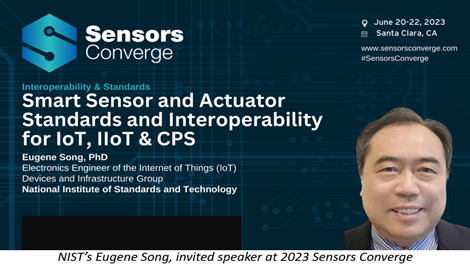
NIST researcher Eugene Song addressed 2023 Sensor Converge, the North America’s largest electronics event for design engineers, on smart sensor and actuator standards and interoperability for Internet of Things (IoT). Song is the Chair of IEEE P1451.0 Working Group for a Smart Transducer Interface for Sensors, Actuators, Devices, and Systems.
Song gave an overview of sensors and actuators and their uses in IoT applications. They sense and signal some physical, chemical, or biological measurement and activate system responses in IoT systems such as smart cities, smart grids, and smart manufacturing. These IoT systems need large numbers of smart sensors and actuators to perform common functions, such as sensing, actuation, time synchronization, identification, localization, processing, and communicating data – and thus the need for interoperability and standards.
Song described the efforts of IEEE P1451.0 Working Group, which defines interfaces and communication specifications for smart sensors and actuators. Notably, the working group is developing a core standard for IEEE 1451 family, which defines:
- Common functions for smart sensors and actuators
- Network services
- Transducer services
- Transducer electronic datasheet formats
- Universal unique identification
- Time synchronization across sensor networks
- Security for sensors and actuators and data
Song described the benefits of these standards. They will aid interoperability across smart sensor and actuator networks, enable the performance of common functions needed on IoTs, and help improve and maintain sensor accuracy. These standards also will facilitate interoperability and plug-and-play at network and sensor levels, make installation, maintenance and upgrades easier, and reduce life-cycle costs. More information related to Song’s presentation can be found at Q&A: Chair of a smart sensors IEEE standard working group hits the basics.

